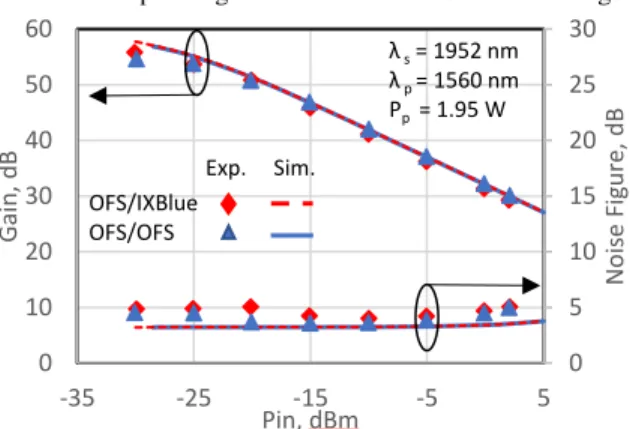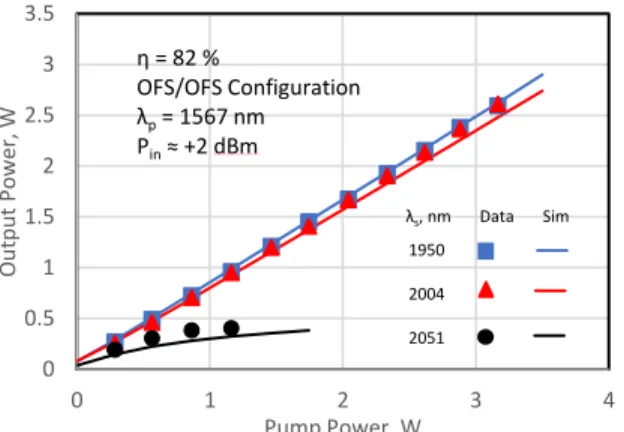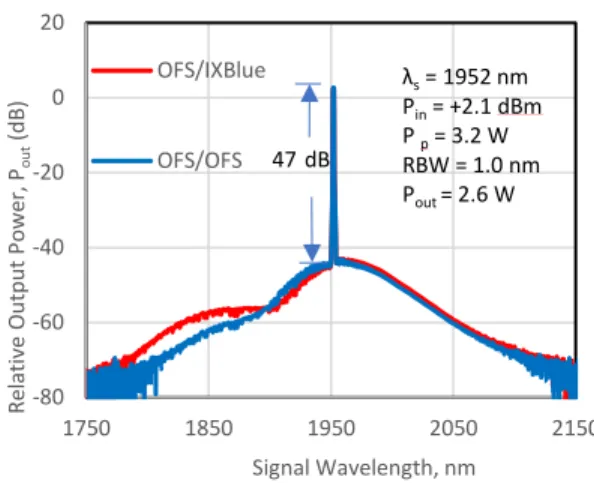HAL Id: hal-01766662
https://hal.archives-ouvertes.fr/hal-01766662
Submitted on 13 Apr 2018
HAL is a multi-disciplinary open access
archive for the deposit and dissemination of
sci-entific research documents, whether they are
pub-lished or not. The documents may come from
teaching and research institutions in France or
abroad, or from public or private research centers.
L’archive ouverte pluridisciplinaire HAL, est
destinée au dépôt et à la diffusion de documents
scientifiques de niveau recherche, publiés ou non,
émanant des établissements d’enseignement et de
recherche français ou étrangers, des laboratoires
publics ou privés.
Broadband 2-W Output Power Tandem Thulium-Doped
Single Clad Fiber Amplifier at 2 µ m
Robert Tench, Clément Romano, Jean-Marc Delavaux
To cite this version:
Robert Tench, Clément Romano, Jean-Marc Delavaux. Broadband 2-W Output Power Tandem
Thulium-Doped Single Clad Fiber Amplifier at 2 µ m. IEEE Photonics Technology Letters,
Insti-tute of Electrical and Electronics Engineers, 2018, 30 (5), pp.503 - 506. �10.1109/LPT.2018.2801840�.
�hal-01766662�
Abstract—We report experimental and simulated performance
of a tandem (dual-stage) Tm-doped silica fiber amplifier with a high signal output power of 2.6 W in the 2 µm band. Combined high dynamic range, high gain, low noise figure, and high OSNR are achieved with our design.
Index Terms—Doped Fiber Amplifiers, Infrared Fiber
Optics, Optical Fiber Devices, Thulium, 2 microns.
I. INTRODUCTION
The recent progress in transmission experiments at signal wavelengths in the 2 µm band [1] shows the need for Thulium-doped fiber amplifiers (TDFAs) with a combination of high gain, low noise figure, and large dynamic range. Previous work has demonstrated single stage amplifiers operating from 1900-2050 nm and 1650-1850 nm [2,3]. In this paper we report the experimental and simulated performance of a tandem single clad TDFA employing in-band pumping around 1560 nm and designed for the 1900-2050 nm signal band. A combination of high gain (> 50 dB), output power of 2.6 W, > 30 dB dynamic range, and < 4 dB small signal noise figure are demonstrated with our design. Performance as a function of input power and signal wavelength is presented. The experimental data are in good agreement with steady-state simulations of our single clad tandem TDFA performance.
II.EXPERIMENTAL SETUP
Figure 1 shows the setup for measurements of the tandem TDFA which consists of a preamplifier (Stage 1) and a power booster (Stage 2). Signal light from a single frequency discrete mode laser (DML) source (Eblana Photonics) is coupled into the first TDF F1 through attenuator A. Signal input power is set by varying the attenuator. In stage 1, fiber 1 is co- and counter-pumped using wavelength division multiplexers (WDMs) with 1550 nm grating stabilized DFBs (P1 and P2) which deliver more than 200 mW each into F1.
Manuscript submitted on December 13, 2017.
Robert E. Tench and Jean-Marc Delavaux are with Cybel LLC, 1195 Pennsylvania Avenue, Bethlehem, PA 18018 USA (e-mail: robert.tench@cybel-llc.com) (e-mail: jm@cybel-llc.com)
Clement Romano is with Cybel LLC, 1195 Pennsylvania Avenue, Bethlehem, PA, 18018 USA, and Institut Telecom/Paris Telecom Tech, 46 Rue Barrault, 75634, Paris, France (e-mail:
clement.romano@cybel-llc.com).
Figure 1. Tandem TDFA configuration.
The signal output of F1 is then coupled into the second TDF fiber F2, in Stage 2, which is counter-pumped either with a multi-watt 1560 nm fiber laser or a multi-watt 1567 nm fiber laser. Optical isolators I1 and I2 suppress parasitic lasing and ensure unidirectional operation. In our experiments, F1 is a 7 m length of OFS TDF designated TmDF200. Two types of fiber F2 are investigated, the first 5 m of OFS TmDF200 and the second 4.4 m of IXBlue TDF designated IXF-TDF-4-125.
III.EXPERIMENTAL RESULTS AND SIMULATIONS
Figure 2 shows the measured gain (G) and noise figure (NF) for the two amplifier configurations, first the OFS/OFS combination and then the OFS/IXBlue combination. In all of our data, which are displayed as points in the figures, input powers are referenced to the input of F1, and output powers are referenced to the output of F2. Maximum values of G of 54.6 dB and 55.8 dB, for OFS/OFS and OFS/IXBlue, respectively, were measured at a signal wavelength λs of
1952 nm for fibre laser pump powers Pp at 1560 nm of 1.95
W. The corresponding NF was measured to be in the range
Figure 2. G and NF as a function of Pin for the two tandem amplifiers at 1952 nm.
of 4.0 to 5.1 dB for the OFS/IXBlue configuration, and 3.6 to 5.0 dB for the OFS/OFS configuration, for input powers
0 5 10 15 20 25 30 0 10 20 30 40 50 60 -35 -25 -15 -5 5 N o is e Fi gu re , d B G ain , d B Pin, dBm λs= 1952 nm λp = 1560 nm Pp = 1.95 W OFS/IXBlue OFS/OFS Exp. Sim.
Broadband 2 W Output Power Tandem Thulium-doped Single Clad
Fiber Amplifier at 2 µm
Pin between -30 dBm and +2 dBm.
The data demonstrate a large dynamic range of over 32 dB for an NF of 5.1 dB or less. For lower fiber laser pump powers (Pp=0.2 W to 0.8 W at 1560 nm), NF values as low
as 3.2 dB were measured for the OFS/OFS configuration. Simulations of these data were performed using fiber parameters measured in our laboratory [4].The simulation is based on a three level model of the Thulium ion in silica using the 3H
6, 3F4, and 3H4 levels including ion-ion
interactions [5]. The parameters of gain coefficient, absorption coefficient, and 3F
4 level lifetime were
determined for the OFS and IXBlue fibers under test. Figure 3 plots the measured gain and absorption coefficients for the OFS fiber, which has a maximum absorption of 92 dB/m at 1630 nm. Figure 4 shows the gain and absorption coefficients for the IXBlue fiber, which has a maximum absorption of 140 dB/m at 1630 nm.
Figure 3. Measured gain and absorption coefficients for the OFS Tm-doped fiber.
Figure 4. Measured gain and absorption coefficients for the IXBlue Tm-doped fiber.
The measured lifetimes are 650 µS for the OFS fiber and 750 µS for the IXBlue fiber. Other relevant parameters were taken from the literature. We note that our measurements of peak gain are lower than the peak absorption. This feature is consistent with some published data but not others [6-9].
The set of three level differential population equations [10] was solved using a stiff solver, while the propagation set of differential equations was solved with a 4th order
Runge-Kutta method. The simulation accounts numerically for the amplified spontaneous emission (ASE) generated in the setup. Two stage simulation was carried out by sequentially applying the results of the single stage calculations.
As illustrated by the solid lines in Figure 2, the simulations agree well with the experimental data. Simulations of G are within 1.5 dB of the data for Pin > -25
dBm. Simulations of NF agree with the data to within 2 dB. These results validate the accuracy of our simulations for both high gain and highly saturated operating regimes.
Data illustrating the variation in output power Pout as a
function of 1567 nm fiber laser pump power Pp are shown in
Figure 5. For these data, Pin was set to between +1.3 and +2.2
dBm to saturate the amplifier and Pp was varied from 0.3 W
to 3.2 W. For the OFS/OFS configuration, a maximum slope
Figure 5. Saturated Pout vs. Pp for the OFS/OFS tandem amplifier.
efficiency of 82% was observed at λs = 2004 and 1952 nm,
corresponding to maximum output powers at these wavelengths of 2.60 W. The slope efficiency is defined as ΔPout /ΔPp. A reduced output power of 0.4 W was achieved
at 2051 nm because of lower slope efficiency and the onset of lasing. Figure 6 illustrates the long term stability
Figure 6. Long term stability of the TDFA output for Pp = 2.43 W.
0 20 40 60 80 100 1400 1600 1800 2000 2200 Ab so rp tio n /G ain (d B.m -1 ) Wavelength, nm 0 40 80 120 160 1400 1600 1800 2000 2200 Ab so rp tio n /G ain (d B/m -1 ) Wavelength, nm
Gain
0 0.5 1 1.5 2 2.5 3 3.5 0 1 2 3 4 O ut pu t P o we r, W Pump Power, W λs, nm Data Sim η = 82 % OFS/OFS Configuration λp= 1567 nm Pin≈ +2 dBm 1950 2004 2051 0 0.5 1 1.5 2 2.5 0 1 2 3 4 5 6 O ut pu t P o we r, W Time, hours λs = 1952 nm λp = 1567 nm Ppump = 2.35 W Pin ≈ +2 dBmAbs.
Gain
Abs.
of Pout at 1952 nm and Pp = 2.43 W over a period of 6 hours.
The variation in Pout over this time period was less than 4%.
No fiber nonlinear behavior such as Raman or Brillouin scattering was observed in our experiments.
Comparison of the data and simulations shows agreement to better than 0.5 dB for all experimental signal wavelengths as illustrated by the solid lines in Figure 5. These results validate the performance of our simulator as a function of signal wavelength.
Slope efficiency data as a function of λs for the
OFS/OFS and OFS/IXBlue setups are shown in Figure 7. Simulated slope efficiencies, given by the solid lines in Figure 7, agree well with the experimental data for all the measured signal wavelengths. The simulations indicate that high slope efficiencies of >70% can be expected from 1900
Figure 7. Slope efficiency as a function of λs for the two tandem
configurations.
nm to 2020 nm. The simulations also show that the single clad fiber can deliver significant output power at 2051 nm with reduced efficiency. We attribute this behavior to the presence of lower wavelength ASE and to reabsorption at lower wavelengths
.
In Figure 8 we contrast experimental output spectra obtained for the two TDFA amplifiers, for saturated input signals of +2.1 dBm at 1952 nm and fiber laser pump power at 1567 nm of 3.2 W. These data are taken under the same conditions and yield optical signal to noise ratios (OSNR) of 57 dB/0.1 nm for both configurations. The spectra observed for both setups exhibit small differences in the wavelength region below 1950 nm. We believe this is caused by the different doping of the two fibers. Nevertheless, the operating wavelength regions and bandwidths for the OFS and IXBlue fibers are largely equivalent. We attribute this similarity to the low concentration of Tm in the two fibers where the scattering and ion-ion interactions can be neglected.
Figure 8. Saturated output spectra for the two tandem configurations.
Figure 9 compares the experimental output spectrum for the OFS/IXBlue configuration with the results of our steady-state simulations. We find that the simulations predict the
Figure 9. Comparison of experimental and simulated output spectra for the OFS/IXBlue configuration.
experimental data relatively well. At low wavelengths <1900 nm, we believe the differences between data and simulation are caused by the wavelength dependence in the passive components and the non-monochromatic spectrum of the single frequency laser source.
IV.DISCUSSION
The high measured internal gain of >55 dB represents a significant improvement over results previously reported [2,3] for single stage TDFAs. Such a high small signal gain is promising for preamplifier, repeater, and low noise applications. 0 20 40 60 80 100 1900 1950 2000 2050 2100 Sl o pe Ef fi ci enc y, % Signal Wavelength, nm Fiber Data Sim OFS/OFS
●
̶ ̶ ̶ ̶ OFS/IXBlue●
̶ ̶ ̶̶ ̶ -80 -60 -40 -20 0 20 1750 1850 1950 2050 2150 R el at iv e O ut pu t P o we r, Po ut (dB ) Signal Wavelength, nm OFS/IXBlue OFS/OFS λs= 1952 nm Pin= +2.1 dBm P p= 3.2 W RBW = 1.0 nm Pout = 2.6 W 47 dB -70 -60 -50 -40 -30 -20 -10 0 1700 1800 1900 2000 2100 R el at iv e O ut pu t P o we r, Po ut (dB ) Signal Wavelength, λ (nm) Pp= 3.2 W, 1567 nm Pout= 2.6 W, 1952 nm OFS/IXBlue configuration Pin = +2 dBm Sim. Expt.The high observed slope efficiency of 82% and output power of 2.6 W also show significant improvement over previously reported performance [2,3]. The experimental SNR of 57 dB/0.1 nm for a saturated amplifier output is important for applications such as booster amplifiers.
The usable operating optical bandwidths of the tandem TDFAs, with the criterion of 10 dB down from the spontaneous emission peak (Figure 8), are estimated to be 122 nm for the OFS/OFS configuration and 130 nm for the OFS/IXBlue configuration. These values agree with previous work [2,3] and are fully consistent with the
simulated slope efficiencies in Figure 7.
Our steady state simulations of tandem TDFA performance agree well with the experimental data, over a range of Pin from -30 dBm to +2 dBm, for measurements of
G, NF, and Pout. This agreement covers the measured
wavelength range of 1910 - 2051 nm. Future work will extend the studied wavelength range toward lower wavelengths. The good agreement between experiment and theory confirms that our simulator is a useful tool for the design of tandem high gain, high power TDFAs.
Finally, we note that both the OFS and IXBlue configurations of the tandem TDFA exhibit similar performance, both experimentally and in simulation, confirming [1-3] that we can employ multiple commercial sources of Tm-doped fiber in our simulation and design of high performance tandem optical amplifiers.
V.SUMMARY
We have reported the design and experimental performance of a tandem single clad TDFA, in-band pumped around 1560 nm and operating in the 1900 – 2050 nm signal band. Small signal gains >55 dB, output powers as high as 2.6 W, and small signal noise figures as low as 3.2 dB were experimentally measured. Slope efficiencies as high as 82% were also observed, and an SNR of 57 dB/0.1 nm was demonstrated with output powers >2 W. Comparison of our data with steady state simulations yielded good agreement, thereby validating our model for high gain and high saturated output powers from the tandem two-stage TDFA over a wavelength range of 1952-2051 nm. Our design is appropriate for high transmit power, preamplifier, and repeater applications in the 2 µm region.
VI.ACKNOWLEDGEMENTS
We are grateful to OFS and IXBlue for the Thulium-doped silica fibers, and to Eblana Photonics for the single frequency source lasers in the 2000 nm band.
VII.REFERENCES
[1] Z. Liu et al., “High-capacity Directly-Modulated Optical Transmitter for 2-µm Spectral Region,” J. Lightwave Technology, Vol. 33, no. 7, pp. 1373-1379 (2015).
[2] Z. Li et al., “Thulium-doped fiber amplifier for optical communications at 2 µm,” Optics Express, Vol. 21, no. 8, pp. 9289-9297 (2013).
[3] Y. Jung et al., “Silica-Based Thulium Doped Fiber Amplifiers for Wavelengths beyond the L-band,” in Proc. OFC 2016, Anaheim, Paper M3D.5 (2016)
[4] C. Romano, R. E. Tench, J-M. Delavaux, and Y. Jaouen, “Characterization of the 3F4-3H6 Transition in Thulium-doped Silica Fibres and Simulation of a 2µm Single Clad Amplifier,” Proc. ECOC 2017, Paper P1.SC1.2, Gothenburg, Sweden, September 2017.
[5] C. Romano, R. E. Tench, Y. Jaouen, and G. Williams, “Simulation and design of a multistage 10 W thulium-doped double clad silica fiber amplifier at 2050 nm,” in Proc. SPIE
10083, Fiber Lasers XIV: Technology and Systems, 100830H
(February 22, 2017).
[6] A. Sincore, J. D. Bradford, J. Cook, L. Shah and M. C. Richardson, “High Average Power Thulium-Doped Silica Fiber Lasers: Review of Systems and Concepts,”, IEEE Journal of Selected Topics in Quantum Electronics, Vol.
24, no. 3, pp. 1-8, May-June 2018.
[7] M. Pisarik et al., “Thulium-doped fibre broadband source for spectral region near 2 micrometers,” Opto-Electronics Review
24(4): 223-231 (2016).
[8] S. D. Agger and J. H. Povlsen, “Emission and absorption cross section of thulium doped silica fibers,” Optics Express 14, 50-57 (2006).
[9] A.V. Smith and J. J. Smith, “Mode instability thresholds for Tm-doped fiber amplifiers pumped at 790 nm,” Optics Express
24, 975-992 (2016).
[10] S. D. Jackson and T. A. King, “Theoretical modeling of Tm- doped silica fiber lasers,” J. Lightwave Technology, Vol. 17, No. 5, pp. 948-956 (1999).


